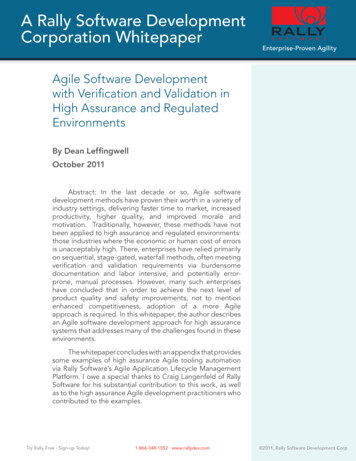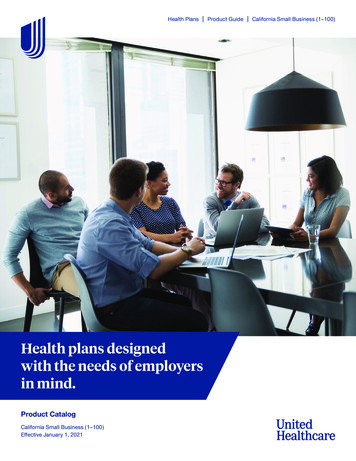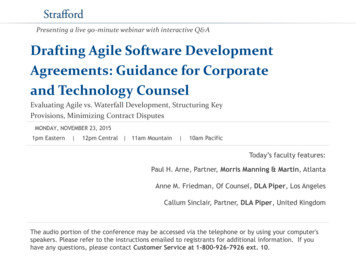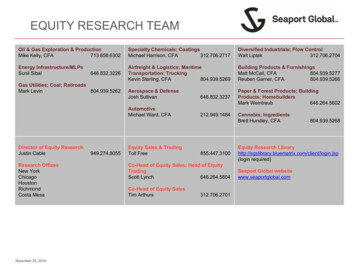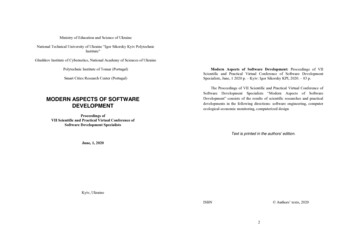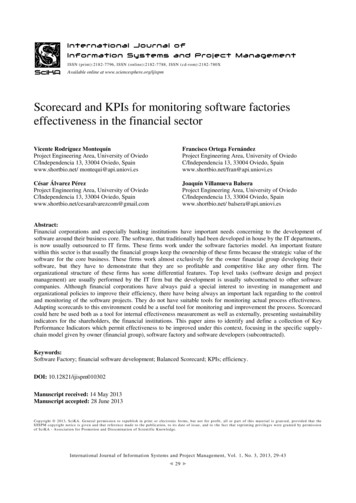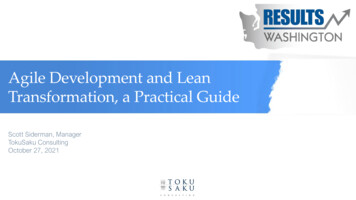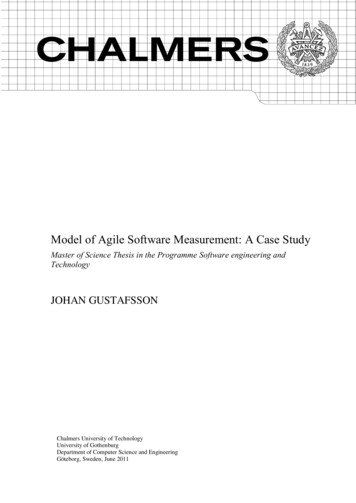
Transcription
A Rally Software Development Corporation WhitepaperAgile Software Development with Verification and Validation inHigh Assurance and Regulated EnvironmentsBy Dean LeffingwellAbstract: In the last decade or so, Agile software development methods have proven their worth in avariety of industry settings, delivering faster time to market, increased productivity, higher quality, andimproved morale and motivation. Traditionally, however, these methods have not been applied to highassurance and regulated environments, those industries where the economic or human cost of errors isunacceptably high. There, enterprises have relied primarily on sequential, stage-gated, waterfall methods,often meeting verification and validation requirements via burdensome documentation and laborintensive, and potentially error prone, manual processes. However, many such enterprises have concludedthat in order to achieve the next level of product quality and safety improvements, not to mentionenhanced competitiveness, adoption of a more agile approach is required. In this whitepaper, the authordescribes an Agile software development approach for high assurance systems that addresses many of thechallenges found in these environments.The whitepaper concludes with an appendix that provides some examples of high assurance Agiletooling automation via Rally Software’s Agile Application Lifecycle Management Platform. I owe a specialthanks to Craig Langenfeld and Yvonne Kish of Rally Software for their substantial contribution to this work,as well as to the high assurance Agile development practitioners who contributed to the examples.
Agile Software Development with Verification and Validation in High Assurance and Regulated EnvironmentsContentsIntroduction. 2Agile Crosses the Chasm to High Assurance Development . 2Introduction to Medical Device Exemplar . 3Regulations and Guidelines for Medical Device Development . 3Regulations . 4Guidelines . 4Software Verification, Validation, and Traceability . 5Software Requirements Specification . 5FDA Guidance is for Concurrent Engineering, NOT Waterfall Development . 6Scaled Agile Delivery Model . 8An Agile, High Assurance Lifecycle Model . 9System Intent, Vision and Product Requirements Document. 10Iterating and Continuous Verification . 11Iterating . 12Define Build Test Teams . 13Agile Requirements Backlog Model. 13User Stories as Software Requirements Specification . 14User Story Verification . 15Traceability from User Story to Code . 15Traceability from Code to Unit Tests . 15Traceability to User Story Acceptance Tests . 15User Story Validation . 16Validating System Increments . 16Validation Sprint Length . 17PRD to SRS Traceability. 17Testing Features . 17Testing Nonfunctional Requirements. 19Finalizing Documents. 20Finalizing Traceability Matrices . 21Conclusion . 21Bibliography. 23About the Author . 23About the Primary Contributor . 24Appendix. 25 2011-2014 Leffingwell, LLC. and Rally Software Development Corporation1
Agile Software Development with Verification and Validation in High Assurance and Regulated EnvironmentsIntroductionOver the last two decades, the movement to iterative, and now Agile, development methods has been one ofthe most important trends affecting the software industry. In Scaling Software Agility [Leffingwell, 2007]and Agile Software Requirements [Leffingwell, 2011], I describe how Agile methods left the realm of smallsoftware teams and programs and are now being applied at enterprise scale. As the methods were relativelynew (er) at the time, I highlighted many of the documented benefits, including increases in productivity,quality, and team morale and job satisfaction. In turn, Agile software enterprises receive the ultimatebeneficial result – improved economic outcomes, higher safety, value, convenience, efficiency, efficacy, andindeed, better standards of living for society at large – that accrue when we improve on this strange mix ofart, science, and engineering that we call software development.When it comes to software quality, it comes as no surprise to Agile proponents that, when properlyimplemented, Agile development achieves much higher quality than its waterfall predecessor. The tyranny ofthe urgent-defect-triage-end-game is largely mitigated. And while we will always need to address defects,non-conformances and minor user need misfires, with Agile we can focus far more on two primary things: 1)better understanding user needs, and 2) building software that has quality, including safety and security, asits organic basis. Given this focus, we now find Agile in another mainstream, those enterprises developingsoftware for medical equipment, pharmaceutics, avionics, military systems, financial trading systems, andother high assurance applications. Here, the presence of any material defect may have an unacceptablehuman or economic cost.In this whitepaper, we describe an Agile approach to developing high assurance software systems. As abaseline, we will explore regulations and guidance associated with the development of medical systems asregulated by the US FDA and similar international agencies. While this will be our example, many otherhigh assurance industries have similar regulations and requirements, and most assume the need to verify andvalidate our requirements and the resultant software application to be sure that our solution works as, andonly as, intended.We describe an Agile lifecycle model that supports the business need for constant feedback and riskidentification and mitigation, and lessens the dependencies on abstract, document-oriented milestones. In itsplace, we will use working code as the basis for feedback and decision-making. We suggest verification andvalidation activities and artifacts that support our need to make sure the system works only and exactly as weintended, and simultaneously provides traceability mechanisms we need to demonstrate these facts to otherstakeholders, including regulatory bodies. The appendix provides examples, screenshots and explanations forvarious reports and artifacts that we can generate using Agile tooling solutions such as Rally Software’sAgile Lifecycle Management Platform, HP’s Quality Center, and Subversion version control systems.Agile Crosses the Chasm to High Assurance DevelopmentBefore we proceed, it is important to know that there is already substantial evidence of successful adoptionAgile development methods in high assurance industries. For example, in Adopting Agile in an FDARegulated Environment [Abbott 2009], Abbot Labs describes how they applied Agile development in thedevelopment of a nucleic acid purification platform in its Molecular Diagnostics business. They also tookthe time to compare the Agile method to a similar predecessor project built with prior, waterfall practices.The conclusions are compelling:(On the new project): Fewer defects were found the availability of working software, early on wasa significant factor.(By comparison to the prior project): We estimate that using an agile approach would haveresulted in the overall project duration being reduced by 20-30%.a headcount reduction of 2030%. and a net cost savings of 35-50%. 2011-2014 Leffingwell, LLC. and Rally Software Development Corporation2
Agile Software Development with Verification and Validation in High Assurance and Regulated Environments(In conclusion): This experience has convinced us that an agile approach is the approach best suitedto development of FDA-regulated devices.As further evidence of this trend, the Association for the Advancement of Medical Instrumentation (AAMI)has recently released a Technical Information Report, which provides extensive recommendations forcomplying with international standards and FDA guidance documents when using Agile practices to developmedical device software1.Agile development is also making significant inroads into other high assurance industries, including noneother than the US Department of Defense. David Rico commented on a recent AFEI2 DoD AgileDevelopment Conference dedicated to promoting Agile acquisition and IT development practices:3It reinforced the U.S. DoD’s commitment to the use of Agile Methods. Furthermore, it wasinteresting to see that Agile Methods are in widespread use by the U.S. DoD, and that no individualorganization, project, group, or person is practicing them in isolation. Prior both the commercialindustry and DoD contractors believed the U.S. DoD was not committed to Agile Methods, which isan enormously incorrect assumption .It’s a popular urban legend that the DoD uses (only)traditional methods such as DoD 5000, CMMI, PMBoK, and other waterfall-based paradigms todevelop IT-intensive systems. The AFEI DoD Agile Development Conference shattered that mythcompletely.Introduction to Medical Device ExemplarThe domain of high assurance development is extremely broad, and regulations and interpretations vary fromindustry to industry. In this whitepaper, we use medical device development under the auspices of the USFood and Drug Administration as an example regulatory environment. In our experience, the expectationsfor practices and compliance in this industry are quite similar to many others, so if we understand this oneinstance, then we might be able to understand something about them all. However, the following disclaimeris appropriate:Regulatory requirements for software differ from industry to industry, and interpretations andenforcement practices are constantly changing. Any suggestions provided in this whitepaper do notconstitute legal or regulatory advice. Information in this whitepaper should only be applied byqualified professionals with direct knowledge of their specific industry.With that disclaimer out of the way, let’s look at regulations and guidance for development of medicaldevices under the auspices of the US FDA.Regulations and Guidelines for Medical Device DevelopmentEach industry has its own thicket of regulatory bodies and published standards that must first be parsed forunderstanding. Figure 1 describes a chain of both regulatory and guidance documents that govern medicaldevice software development as provided for under the US FDA Code of Federal Regulations (CFR) 21.41The AAMI Technical Information Report TIR-45: Guidance on the Use of Agile Practices in the Development of Medical DeviceSoftware: Info can be found at http://my.aami.org/store/detail.aspx?id TIR45-PDF.2The Association for Enterprise Information (AFEI). See http://www.afei.org/Pages/default.aspx.3See http://davidfrico.com/afei-2010.doc4Note: while this post and thread focuses on US FDA Good Manufacturing Practices (GMP) requirements for medical devices, theserequirements are generally harmonized with International Organization for Standards (ISO) 9001:1994 and ISO DIS 13485. 2011-2014 Leffingwell, LLC. and Rally Software Development Corporation3
Agile Software Development with Verification and Validation in High Assurance and Regulated EnvironmentsFigure 1Regulatory and guidance documents for US medical device developmentA summary explanation of these documents is provided in the paragraphs below.RegulationsIn our case, the law starts with the US Code of Federal Regulations (CFR), which is the law of the land in theU.S. Title 21 of the CFR, is reserved for rules of the Food and Drug Administration (FDA). Here, we findthe following additional “sub” regulations.CFR 21 Subchapter H – Medical Devices. Covers the general design, manufacture and marketing ofmedical devices.CFR 21 Part 820 Quality System Regulation. Defines specific regulatory requirements for the designand development of such devices, intended to ensure that finished devices will be safe and effectiveand otherwise in compliance with the Federal Food, Drug, and Cosmetic Act.Quality System Regulation, CFR21 Part 820.30 Subpart C Design Controls. Subpart C specifies theregulations for device design (including software development in our case). Regulatory requirementsfor device verification and validation are included here.GuidelinesCFR 820.30 is the regulation that covers all medical devices, whether they include software or not. It isremarkably short (just 2 pages!) and provides lots of leeway to device manufacturers. It is important to notethat this document, at the bottom of the chain, contains all of, and the only specific federal regulations whichgovern medical device development.However, as an aid to FDA staff and the industry, CDRH has published additional guidelines that addspecificity to how these regulations will be interpreted. First, for 820.30, Design Controls, there is thepublication Design Control Guidance for Medical Device Manufacturers, [FDA CDRH 1997]. It isimportant to note that these guidelines are just that, guidelines, and they do not have the force of regulation.However, they do set expectations on the part of the industry and regulators as to how the regulations shouldbe generally interpreted.And finally, and more specifically to our context, CDRH has published a document which providesguidelines for the general principles of software validation, General Principles of Software Validation; FinalGuidance for Industry and FDA Staff, [FDA CDRH 2002]. 2011-2014 Leffingwell, LLC. and Rally Software Development Corporation4
Agile Software Development with Verification and Validation in High Assurance and Regulated EnvironmentsSoftware Verification, Validation, and TraceabilityCFR 21 Part 830 Subpart C Design Controls, Paragraphs (f), (g) mandate device design verification andvalidation. In General Principles of Software Validation [FDA CDRH 2002], we find:Software verification provides objective evidence that the design outputs of a particular phase of thesoftware development life cycle meet all of the specified requirements for that phase. Softwareverification looks for consistency, completeness, and correctness of the software and its supportingdocumentation, as it is being developed, and provides support for a subsequent conclusion thatsoftware is validated. In other words, verification ensures that “you built it right.”Software validation is confirmation by examination and provision of objective evidence thatsoftware specifications conform to user needs and intended uses, and that the particular requirementsimplemented through software can be consistently fulfilled. Since software is usually part of a largerhardware system, the validation of software typically includes evidence that all softwarerequirements have been implemented correctly and completely and are traceable to systemrequirements. In other words, validation ensures that “you built the right thing.”In addition, the guidelines go on to describe traceability and traceability analysis as primary mechanisms toassure that verification and validation are complete and consistent, and that a traceability matrix is thedocumentation record that provides the objective evidence of the completeness of the verification andvalidation. For definitions here, we refer to FDA Glossary of Computer Systems Software DevelopmentTerminology5:Traceability. (from IEEE) (1) The degree to which a relationship can be established between two ormore products of the development process, especially products having a predecessor-successor ormaster-subordinate relationship to one another; e.g., the degree to which the requirements and designof a given software component match. (2) The degree to which each element in a softwaredevelopment product establishes its reason for existing.Traceability Analysis. (from IEEE) The tracing of (1) Software Requirements Specificationsrequirements to system requirements in concept documentation, (2) software design descriptions tosoftware requirements specifications and software requirements specifications to software designdescriptions, (3) source code to corresponding design specifications and design specifications tosource code. Analyze identified relationships for correctness, consistency, completeness, andaccuracy.Traceability Matrix. (from IEEE) A matrix that records the relationship between two or moreproducts; e.g., a matrix that records the relationship between the requirements and the design of agiven software component.Software Requirements SpecificationIn addition to these definitions, this document [FDA CDRH 2002] also provides an introduction anddefinition to another important artifact:A documented software requirements specification (SRS) provides a baseline for both validation andverification. The software validation process cannot be completed without an established softwarerequirements specification (Ref: 21 CFR 820.3(z) and (aa) and 820.30(f) and (g)).From the guidance, such a document typically contains: All software system inputs, outputs, and functions All performance requirements, including throughput, reliability, accuracy, response times (i.e., allnonfunctional requirements)5see FDA Glossary of Computer Systems Software Development Terminology on line uides/ucm074875.htm 2011-2014 Leffingwell, LLC. and Rally Software Development Corporation5
Agile Software Development with Verification and Validation in High Assurance and Regulated Environments Definition of external and user interfacesUser interactionsOperating environments (platforms, operating systems, other applications)All ranges limits, defaults and specific values the software will acceptAll safety related requirements specifications, features, or functions implemented in softwareClearly, the verification and validation (V&V) aspects of the regulations essentially mandate the creation asoftware requirements specification6. In contrast, non-high assurance Agile development teams don’ttypically create these in a formal way; instead they use the backlog, collections of user stories andacceptance criteria, persistent test cases and the code itself (i.e.: with defined templates for auto insertion ofcode header information and checkin code comments) to document system behavior. However, in thiscontext, it is clear that we will need to develop and maintain a software requirements specification, as wesimply cannot do V&V without it. However, the fact that we need such a document doesn’t mandate that wedo it all Big Bang and Up-Front. To be agile, we can and will develop it incrementally with the artifactsincrementally generated within agile teams. The benefit here on agile teams is that the documentation iscontinuously updated with the agile team artifacts, so documentation is not done after the fact.FDA Guidance is for Concurrent Engineering, NOT Waterfall Development[FDA CDRH 2002] (40 pages) provides the most specific guidance applicable to the validation of medicaldevice software. It is important to note, that neither this document, nor CFR820.30 itself, constrainsdevelopment to single pass, stage-gated, waterfall activities.From General Principles of Software Validation . [FDA CDRH 2002]: This guidance recommendsan integration of software life cycle management and risk management activities. While thisguidance does not recommend any specific life cycle model or any specific technique or method, itdoes recommend that software validation and verification activities be conducted throughout theentire software life cycle.From Design Control Guidance for Medical Device Manufacturers [FDA CDRH 1997]: Althoughthe waterfall model is a useful tool for introducing design controls, its usefulness in practice islimited for more complex devices, a concurrent engineering model is more representative of thedesign processes in use in the industry.Even more specifically, IEC62304, (a widely recognized international standard for medical devicesoftware which is largely harmonized with FDA’s interpretation of CFR 820.30) states: theseactivities and tasks may overlap or interact and may be performed iteratively or recursively. It is notthe intent to imply that a waterfall model should be used.Notwithstanding the above, and whether we are doing high-assurance development or not, it is likely that ourenterprise’s standard approach to software development followed the over-simplified waterfall model. Afterall, that’s what most of us have done for years, so why would the high assurance development teams be anydifferent? To be flippant for a moment, perhaps we headed down this path because it’s simply easier to draw.Actually, we have done this for years because the linear waterfall SDLC phase gates are so easy to map tomilestones for management and they fit in so neatly with linear management forecasts and budgets forformal phase gate reviews (i.e., SRR, PDR, CDR, TRR, etc.) as seen in Figure 3 below. For example, indescribing the application of design controls, [FDA CDRH 1997] provides the following diagram.6For further description of the contents of an SRS, refer to IEEE Recommended Practice for Software Requirements Specificationsand Managing Software Requirements: A Unified Approach [Leffingwell and Widrig 1997]. 2011-2014 Leffingwell, LLC. and Rally Software Development Corporation6
Agile Software Development with Verification and Validation in High Assurance and Regulated EnvironmentsFigure 2 Application of design controls to waterfall design process. From [FDA CDRH 1997] Design ControlGuidance for Medical Device ManufacturersMost readers will recognize Figure 2 as being typical of more generic, traditional waterfall softwaredevelopment process models, such as that pictured in Figure 37.Figure 3A traditional waterfall model view of software developmentIn addition, V&V activities are often aligned with a traditional waterfall approach depicted above with thecommonly known V-model depicted in Figure 4 below. In the V-model, each phase of development isaligned with the type of V&V activities, which heavily includes testing, for each phase.7Note to the software historians: Winston Royce’s seminal 1970 article, which initially described the sequential model which cameto be known as the waterfall model, included the following statement “I believe in this concept (analysis before coding etc) , butthe implementation above (a sequential, single pass, reqs-analysis-design-coding-testing) is risky and invites failure.” In otherwords, he concluded that the waterfall model, as we often imply today is NOT a recommended model for development. 2011-2014 Leffingwell, LLC. and Rally Software Development Corporation7
Agile Software Development with Verification and Validation in High Assurance and Regulated EnvironmentsFigure 4A traditional V Model view of software development phases aligned with V&V and testing phasesSuch diagrams, familiar to us all, offer some positive attributes, at least on the surface: It is seemingly simple and logical (what could be more logical than code following requirements,and tests following that?) In theory, you only have to do “it all” once (especially verification and validation, which can be bothlabor intensive, expensive and error prone).Of course, we know it doesn’t work well that way, and that’s why we strive for agility in the high assurancemarkets, just like we do everywhere else. However, for many, the apparently beguiling (but false) simplicityof the model is one reason that it has made its way into the various governing documents, milestone reviews,corporate quality standards, etc.Let us be clear: with respect to this one industry, and with respect to these specific guidelines, any notionthat we are mandated to apply a single-pass, waterfall model to software development is an industry myth,one which has likely been perpetuated by our own waterfall past (“we have always done it this way”) andour existing quality management systems, and not because “the regulations make us do it”.Scaled Agile FrameworkAs we noted earlier, many enterprises have already moved to a scalable Agile development model. Base donthese experiences in the field, we have evolved a full-fledged, public-facing framework, which can be foundat ScaledAgileFramework.com. The Frameworks “Big Picture” serves as its UI and navigation paradigm, asFigure 5 illustrates: 2011-2014 Leffingwell, LLC. and Rally Software Development Corporation8
Agile Software Development with Verification and Validation in High Assurance and Regulated EnvironmentsFigure 5 Big Picture of the Scaled Agile Framework.Source: ScaledAgileFrameowrk.comThis framework has a number of interesting attributes, many of which we will be able to apply directly to ourhigh assurance context: Software development proceeds in a short series of iterations (or Sprints) For requirements, Agile teams work against their local, project backlog, which consists primarily ofuser stories that are written just prior to the iteration in which they are implemented Teams break stories down into tasks, which is a fine grained work breakdown structure (which wewill put to good use shortly) Teams work against a common program backlog, comprised of a set of features which describe thesystem intent, or solution Vision Periodically, the teams collaborate on a HIP sprint, used to eliminate any remaining technical debt,perform full system integration and regression testing, and to finalize documentation At the end of each HIP sprint, the program has produced a release (or Potentially ShippableIncrement) of the full software asset stack.An Agile, High Assurance Lifecycle ModelThe Agile model above is robust and scalable, and has been successfully applied in a number of industries.However it does not assume the development of specific requirements documents, nor explicit verificationand validation, so we extend this a bit in the high assurance context. With a nod to the model above and theAbbot Labs whitepaper [Abbot 2009], and with due respect to the necessary verification and validation 2011-2014 Leffingwell, LLC. and Rally Software Development Corporation9
Agile Software Development with Verification and Validation in High Assurance and Regulated Environmentsactivities, we offer Figure 6 as a model for Agile, iterative and incremental development in high assurancemarkets:Figure 6An Agile, high assurance lifecycle modelIn this model, we use a series of short system iterations, each of which defines, builds and ve
A Rally Softw
